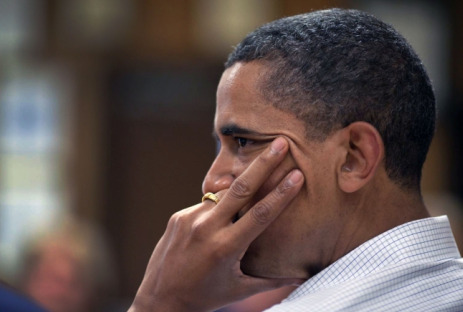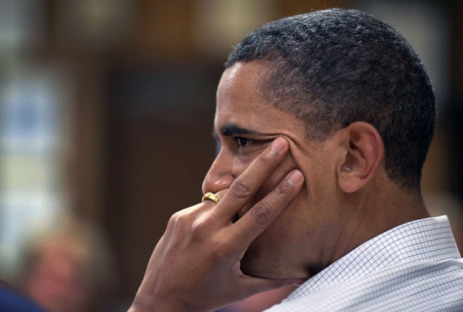 Obama listens during a briefing on the BP oil spill by National Incident Commander Admiral Thad Allen at the U.S. Coast Guard Station in Grand Isle, Louisiana. Photo and caption: The White HouseBarack Obama is doing his darnedest to show his world now revolves around the BP oil spill — he’ll make his fourth trip to the Gulf next week — but it’s hard to shake the feeling that while it may not be too little, it’s definitely too late. This week’s investigative piece in Rolling Stone, “The Spill, the Scandal and the President” by Tim Dickinson, only feeds those doubts. Dickinson’s report makes it painfully clear that while George Bush set this disaster in motion, Obama did little to slow it down. The Rolling Stone expose clocks in at more than 8,000 words. If you don’t have time to read the whole thing, here’s the CliffsNotes:
Obama listens during a briefing on the BP oil spill by National Incident Commander Admiral Thad Allen at the U.S. Coast Guard Station in Grand Isle, Louisiana. Photo and caption: The White HouseBarack Obama is doing his darnedest to show his world now revolves around the BP oil spill — he’ll make his fourth trip to the Gulf next week — but it’s hard to shake the feeling that while it may not be too little, it’s definitely too late. This week’s investigative piece in Rolling Stone, “The Spill, the Scandal and the President” by Tim Dickinson, only feeds those doubts. Dickinson’s report makes it painfully clear that while George Bush set this disaster in motion, Obama did little to slow it down. The Rolling Stone expose clocks in at more than 8,000 words. If you don’t have time to read the whole thing, here’s the CliffsNotes:
Change he needed
Like the attacks by Al Qaeda, the disaster in the Gulf was preceded by ample warnings — yet the administration had ignored them. Instead of cracking down on MMS, as he had vowed to do even before taking office, Obama left in place many of the top officials who oversaw the agency’s culture of corruption. He permitted it to rubber-stamp dangerous drilling operations by BP — a firm with the worst safety record of any oil company — with virtually no environmental safeguards, using industry-friendly regulations drafted during the Bush years. He calibrated his response to the Gulf spill based on flawed and misleading estimates from BP — and then deployed his top aides to lowball the flow rate at a laughable 5,000 barrels a day, long after the best science made clear this catastrophe would eclipse the Exxon Valdez.
Dressed to drill
(Ken) Salazar did little to tamp down on the lawlessness at MMS, beyond referring a few employees for criminal prosecution and ending a Bush-era program that allowed oil companies to make their “royalty” payments — the amount they owe taxpayers for extracting a scarce public resource — not in cash but in crude. And instead of putting the brakes on new offshore drilling, Salazar immediately throttled it up to record levels. Even though he had scrapped the Bush plan, Salazar put 53 million offshore acres up for lease in the Gulf in his first year alone — an all-time high. The aggressive leasing came as no surprise, given Salazar’s track record … As a senator, Salazar not only steered passage of the Gulf of Mexico Energy Security Act, which opened 8 million acres in the Gulf to drilling, he even criticized President Bush for not forcing oil companies to develop existing leases faster.
Spoiler alert!
In May 2000, an environmental assessment for deepwater drilling in the Gulf presciently warned that “spill responses may be complicated by the potential for very large magnitude spills (because of the high production rates associated with deepwater wells).” The report noted that the oil industry “has estimated worst-case spill volumes ranging from 5,000 to 116,000 barrels a day for 120 days,” and it even anticipated the underwater plumes of oil that are currently haunting the Gulf: “Oil released subsea (e.g., subsea blowout or pipeline leak) in these deepwater environments could remain submerged for some period of time and travel away from the spill site.” The report ominously concluded: “There are few practical spill-response options for dealing with submerged oil.”
That same month, an MMS research document developed with deepwater drillers — including the company then known as BP Amoco — warned that such a spill could spell the end for offshore operations. The industry could “ill afford a deepwater blowout,” the document cautions, adding that “no single company has the solution” to such a catastrophe. “The real test will come if a deepwater blowout occurs.”
Safety last
BP shaved $500,000 off its overhead by deploying a blowout preventer without a remote-control trigger — a fail-safe measure required in many countries but not mandated by MMS, thanks to intense industry lobbying. It opted to use cheap, single-walled piping for the well, and installed only six of the 21 cement spacers recommended by its contractor, Halliburton — decisions that significantly increased the risk of a severe explosion. It also skimped on critical testing that could have shown whether explosive gas was getting into the system as it was being cemented, and began removing mud that protected the well before it was sealed with cement plugs.
The buck stops where?
The effect of leaving BP in charge of capping the well, says a scientist involved in the government side of the effort, has been “like a drunk driver getting into a car wreck and then helping the police with the accident investigation.” Indeed, the administration has seemed oddly untroubled about leaving the Gulf’s fate in the hands of a repeat criminal offender, and uncurious about the crimes that may have been committed leading up to the initial sinking of the rig. The Obama Justice Department took more than 40 days after the initial blast killed 11 workers to announce it was opening a criminal probe.
NOAA means no
Scientists were stunned that NOAA, an agency widely respected for its scientific integrity, appeared to have been co-opted by the White House spin machine. “NOAA has actively pushed back on every fact that has ever come out,” says one ocean scientist who works with the agency. “They’re denying until the facts are so overwhelming, they finally come out and issue an admittance.” Others are furious at the agency for criticizing the work of scientists studying the oil plumes rather than leading them. “Why they didn’t have vessels there right then and start to gather the scientific data on oil and what the impacts are to different organisms is inexcusable,” says a former government marine biologist. “They should have been right on top of that.” Only six weeks into the disaster did the agency finally deploy its own research vessel to investigate the plumes.
The devil made him do it
President Obama pushed to expand offshore drilling, in part, to win votes for climate legislation, which remains blocked in the Senate. The political calculus is understandable — the risk of an oil spill weighed against the far greater threat posed by global warming — but in the end, he may have succeeded only in compounding one environmental catastrophe with another. Even if the climate bill is eventually approved, the disaster in the Gulf will serve as a lasting and ugly reminder of the price we paid for our addiction to oil. “It was a bargain with the devil,” says (Rick) Steiner, the marine scientist who helped lead the response to the Valdez disaster. “And now the devil is gloating.”


